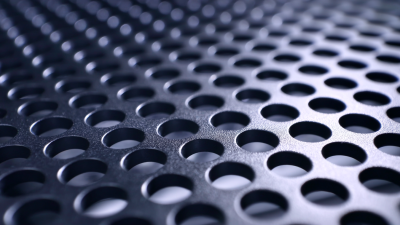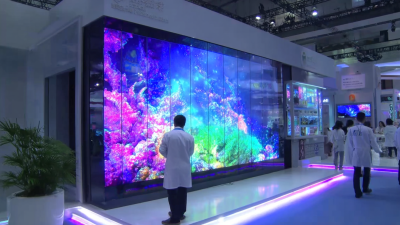 No. 14, Building 2, No. 367 Beijing Road, Chengdu Economic and Technological Development Zone (Longquanyi District)
No. 14, Building 2, No. 367 Beijing Road, Chengdu Economic and Technological Development Zone (Longquanyi District)

The demand for Pu Screen Panels is witnessing remarkable growth as industries seek innovative solutions to enhance operational efficiency. According to a recent industry report, the global market for screening panels is projected to reach USD 2 billion by 2025, with a compound annual growth rate (CAGR) of 8% from 2021 to 2025. This surge can be attributed to the increasing adoption of lightweight and durable materials that offer superior performance across various applications, including mining, construction, and waste management.
As we delve into the top trends shaping the future of Pu Screen Panels, it is essential to consider the technological advancements driving these innovations. Key developments such as the integration of advanced materials and smart technologies are revolutionizing the screening process, resulting in higher efficiency and reduced operating costs. Moreover, the growing emphasis on sustainability and environmentally friendly practices is encouraging manufacturers to develop eco-conscious products without compromising on durability and performance.
These innovations not only address the evolving demands of industries but also set the stage for a competitive landscape in the Pu Screen Panel market. As businesses increasingly recognize the importance of investing in cutting-edge screening solutions, the industry is poised for significant transformation, paving the way for enhanced productivity and growth.

The production of PU screen panels is evolving rapidly, with sustainability becoming a central theme in the industry. As environmental concerns gain traction, manufacturers are increasingly turning to sustainable materials, which not only reduce the ecological footprint but also appeal to eco-conscious consumers. These innovative materials can enhance the durability and performance of PU screen panels while minimizing waste in production processes.
Tips for incorporating sustainable materials into your production: First, consider using bio-based polyurethanes derived from renewable resources such as plant oils. This not only contributes to sustainability but can also improve the overall aesthetic quality of your products. Additionally, collaborating with suppliers who prioritize green practices can further enhance your sustainability strategy.
Incorporating recycling initiatives is another way to drive sustainability in PU screen panel production. Implementing a program to recycle waste materials back into the manufacturing process can not only reduce costs but also promote a circular economy. This approach is beneficial not only for the environment but also for businesses looking to position themselves as leaders in sustainability.

Recent advancements in manufacturing techniques are significantly enhancing the quality and efficiency of PU screen panels, propelling the industry toward a new era of innovation. The integration of automated production lines has streamlined the manufacturing process, allowing for precision and consistency in panel thickness and texture. Additionally, the adoption of advanced materials and coatings has improved the durability and performance of these panels, making them more resilient to environmental factors and wear over time.
Furthermore, the implementation of smart technology in the manufacturing process is revolutionizing how PU screen panels are produced. Real-time monitoring systems enable manufacturers to track the quality of output continuously, reducing waste and increasing productivity. The use of computer-aided design (CAD) software also allows for customized solutions tailored to specific customer needs, further driving demand in the market. As these innovations continue to evolve, they promise to reshape the landscape of the PU screen panel industry, resulting in higher standards and enhanced competitive advantage for manufacturers.
This chart illustrates the top trends driving innovation and growth in the PU screen panels industry for 2025. Key areas of advancement include the use of advanced materials, the rise of eco-friendly solutions, the integration of smart technologies, increasing customization options, and a focus on cost efficiency.
The integration of smart technology into PU screen panels is set to revolutionize the industry by enhancing functionality and user experience. With advancements in IoT and automation, these panels can now offer real-time monitoring and control capabilities. For instance, integrating sensors can allow users to detect wear and tear in the panels, enabling timely maintenance and reducing potential downtime.
Tips for adopting smart technology in PU screen panels include ensuring compatibility with existing systems and conducting a thorough assessment of your operational needs. Additionally, investing in scalable solutions will prepare your business for future growth while avoiding the pitfalls of over-automation. It's also essential to train your staff on the new systems to maximize efficiency.
As industries increasingly adopt eco-friendly practices, integrating smart technology into PU screen panels not only boosts productivity but also aligns with sustainability goals. Emphasizing energy efficiency and resource optimization can drive cost savings while meeting modern environmental standards. By leveraging these innovations, companies can stay ahead of the competition in a rapidly evolving market.
| Trend | Description | Impact on Industry | Expected Growth (%) | Implementation Year |
|---|---|---|---|---|
| Smart Integration | Integration of IoT technologies for real-time monitoring and control. | Enhances operational efficiency and reduces downtime. | 25% | 2025 |
| Eco-Friendly Materials | Use of recycled and sustainable materials in panel production. | Appeals to environmentally conscious consumers and reduces carbon footprint. | 30% | 2025 |
| Advanced Coating Technologies | New coatings for enhanced durability and performance. | Increases product lifespan and customer satisfaction. | 20% | 2024 |
| Customization Options | Offering tailored solutions for specific customer needs. | Enhances customer loyalty and allows for niche market expansion. | 15% | 2025 |
| Automation in Manufacturing | Incorporating automated systems to improve production efficiency. | Reduces labor costs and increases production speed. | 28% | 2024 |
The growing demand for customizable design solutions in the market of PU screen panels reflects a significant shift toward personalization and adaptability in industrial applications. As industries seek to optimize their operations, the ability to tailor screen panels to specific requirements has become a critical factor. Customization not only enhances functionality but also allows companies to differentiate their products, meeting the unique preferences and aesthetic desires of their clients.

Furthermore, advancements in technology are driving this trend, enabling manufacturers to offer a wider array of design options that cater to various industries. Innovations such as digital printing and automated production processes facilitate the creation of bespoke panel designs, providing businesses with greater flexibility and efficiency. This move toward personalization not only boosts consumer satisfaction but also contributes to the overall growth of the PU screen panel industry, as companies increasingly recognize the value of aligning their products with market demands.
The landscape of polyurethane (PU) screen panels is undergoing significant transformation, largely influenced by recent regulatory changes. As industries face stricter environmental standards and quality controls, manufacturers are innovating to not only comply but also to thrive. According to a recent report by the International Polymer Engineering Association, the market for PU screen panels is projected to grow at a CAGR of 5.8% from 2023 to 2028, fueled by advancements in eco-friendly materials and sustainable production processes.
To adapt to these regulatory shifts, companies are investing in R&D to create panels that meet new compliance requirements while enhancing performance. For instance, innovations such as the incorporation of recycled materials in PU screens are becoming more prevalent, leading to reduced waste and improved lifecycle assessments. Companies that pivot quickly to adopt these sustainable practices are seeing higher customer retention rates, as consumers increasingly favor environmentally responsible products.
Tips: When selecting PU screen panels, ensure to review their compliance with current regulations in your region. Additionally, consider options that highlight sustainability, as these products not only help meet legal requirements but also contribute to a greener footprint. Moreover, staying informed about ongoing regulatory changes can provide a competitive edge in the rapidly evolving market.





